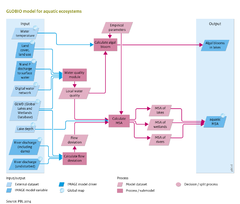Aquatic biodiversity/Policy issues: Difference between revisions
Jump to navigation
Jump to search
m (Text replace - "|Status=On hold" to "") |
No edit summary |
||
| Line 1: | Line 1: | ||
{{ComponentPolicyIssueTemplate | {{ComponentPolicyIssueTemplate | ||
|Description=The GLOBIO model for aquatic ecosystems simulates average biodiversity intactness (MSA) in freshwater biomes under different baseline assumptions (assuming no new policies). This scenario shows that considerable decline in MSA is projected for most regions, and that this will continue throughout the 2010–2050 period, particularly in Africa (Figure 7.2.2) (PBL, 2010; OECD, 2012). The simulated declines are likely to be an underestimation, because the effects of wetland reclamation and future planned river dams and climate change have not yet been included in these projections. Algal bloom problems in lakes due to eutrophication with phosphorus and nitrogen will increase as well. | |||
|Example=Several options could help avoid the reduction in the MSA value of future aquatic biodiversity. The combined options scenario involves an expansion of protected areas, a reduction of agricultural area due to consumption changes and reduced food losses, an increase of agricultural productivity and animproved efficiency of nutrient use while reducing emissions. The IMAGE calculations show this option may even allow some recovery of already lost biodiversity (increasing MSA) on a local level (Figure 7.2.3). However, this may be counteracted by the effects of climate change (e.g. Mooij et al., 2005; Jeppesen et al., 2009). With respect to agricultural intensification, there may be a trade-off between increased biodiversity loss on a local scale and decreased loss on catchment scale. | |||
}} | }} | ||
Revision as of 13:16, 26 March 2014
Parts of Aquatic biodiversity/Policy issues
| Component is implemented in: |
|
| Projects/Applications |
| Models/Databases |
| Key publications |
| References |
